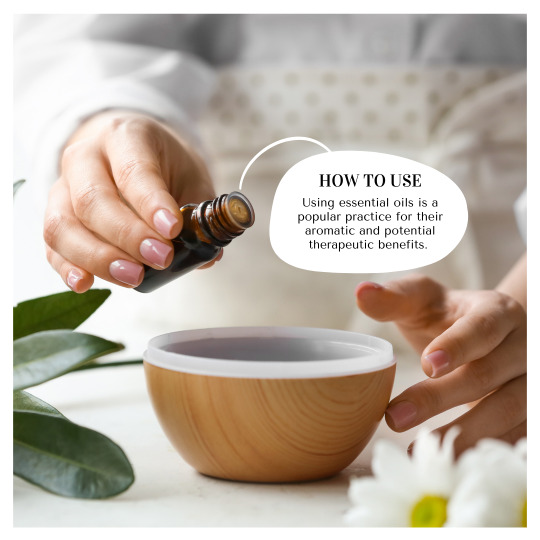Text
How to Safely Use Essential Oils: Dilution and Application Methods
Essential oils have gained significant popularity in recent years for their aromatic and therapeutic properties. However, it is essential to understand that these concentrated plant extracts should be used with caution and care. Dilution and proper application methods are crucial for ensuring the safe and effective use of essential oils. In this blog post, we will explore the importance of dilution and various application methods to help you incorporate essential oils into your daily routine safely.

Understanding Dilution:
Dilution is the process of reducing the concentration of essential oils by mixing them with a carrier oil or another suitable substance. Undiluted essential oils can be potent and may cause skin irritation, sensitization, or other adverse reactions. By diluting essential oils, you reduce the risk of these reactions while still benefiting from their therapeutic properties.
Here are some general guidelines for diluting essential oils:
a. Adults: For topical application on the body, a 2% dilution is typically recommended. This means adding approximately 12 drops of essential oil to 1 fluid ounce (30 ml) of carrier oil.
b. Children and elderly individuals: Due to their more sensitive skin, a lower dilution of 1% is recommended. This translates to approximately 6 drops of essential oil per 1 fluid ounce (30 ml) of carrier oil.
c. Facial application: When using essential oils on the face, it is advisable to use an even lower dilution, around 0.5% to 1%. This is equivalent to 3-6 drops of essential oil per 1 fluid ounce (30 ml) of carrier oil.
Remember, these are general guidelines, and some essential oils may require further dilution or have specific recommendations. Always refer to reliable sources or consult with a qualified aromatherapist or healthcare professional.
Topical Application Methods:
Topical application is one of the most common ways to use essential oils. However, it's crucial to follow proper techniques to ensure safety and maximize benefits. Here are a few key points to keep in mind:
a. Patch test: Before applying an essential oil topically, perform a patch test on a small area of skin to check for any adverse reactions. Dilute the essential oil as recommended and apply a small amount to the inner arm or wrist. If any redness, itching, or irritation occurs, discontinue use.
b. Massage: Diluted essential oils can be used in massage oils for relaxation, muscle tension relief, or other therapeutic benefits. Remember to choose a carrier oil suitable for your skin type and mix in the appropriate amount of essential oil according to the dilution guidelines.
c. Targeted application: For specific concerns like insect bites, minor burns, or blemishes, you can apply diluted essential oils directly to the affected area. Be cautious around sensitive areas such as the eyes, mucous membranes, or broken skin.
Inhalation Methods:
Inhaling essential oils can offer various benefits, including mood enhancement and respiratory support. Here are a few safe inhalation methods:
a. Diffusion: Use an essential oil diffuser to disperse the oils into the air. Follow the manufacturer's instructions for adding the recommended number of drops of essential oil. Ensure proper ventilation in the room and limit diffuser use to 30-60 minutes at a time.
b. Steam inhalation: Add a few drops of essential oil to a bowl of hot water, cover your head with a towel, and inhale the steam. This method can provide relief for congestion or sinus issues. Keep your eyes closed during steam inhalation to avoid irritation.
c. Aromatic jewelry or inhalers: These portable options allow you to enjoy the benefits of essential oils throughout the day. Ensure proper dilution when using essential oils with such products and follow the manufacturer's instructions.
Conclusion:
Using essential oils can be a delightful and therapeutic experience when done safely. Dilution is essential to prevent adverse reactions, and following the appropriate application methods will enhance the efficacy of these potent plant extracts. Remember to always research essential oils before use, consult reputable sources, and seek guidance from professionals if needed. By practicing safe dilution and application techniques, you can fully enjoy the aromatic and therapeutic benefits of essential oils while prioritizing your well-being.
#wellness#essential oils#natural oils#health#using essential oil#Fitness#fitnessmotivation#skin treatment#glowing skin#anti aging#health tips#health and fitness#skin care
1 note
·
View note